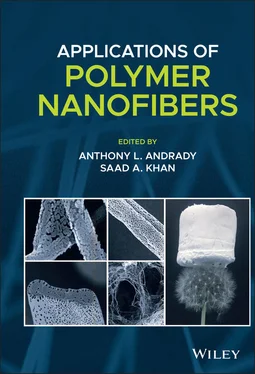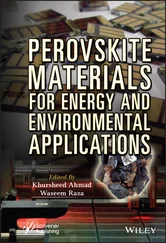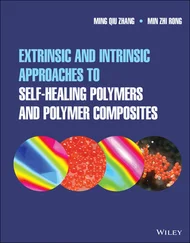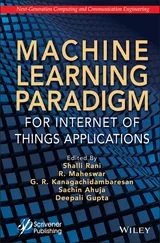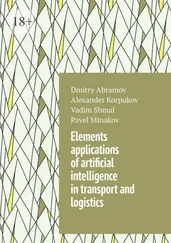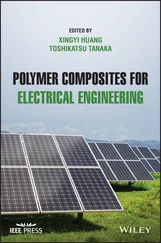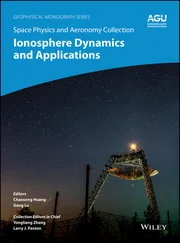Applications of Polymer Nanofibers
Здесь есть возможность читать онлайн «Applications of Polymer Nanofibers» — ознакомительный отрывок электронной книги совершенно бесплатно, а после прочтения отрывка купить полную версию. В некоторых случаях можно слушать аудио, скачать через торрент в формате fb2 и присутствует краткое содержание. Жанр: unrecognised, на английском языке. Описание произведения, (предисловие) а так же отзывы посетителей доступны на портале библиотеки ЛибКат.
- Название:Applications of Polymer Nanofibers
- Автор:
- Жанр:
- Год:неизвестен
- ISBN:нет данных
- Рейтинг книги:4 / 5. Голосов: 1
-
Избранное:Добавить в избранное
- Отзывы:
-
Ваша оценка:
- 80
- 1
- 2
- 3
- 4
- 5
Applications of Polymer Nanofibers: краткое содержание, описание и аннотация
Предлагаем к чтению аннотацию, описание, краткое содержание или предисловие (зависит от того, что написал сам автор книги «Applications of Polymer Nanofibers»). Если вы не нашли необходимую информацию о книге — напишите в комментариях, мы постараемся отыскать её.
Explore a comprehensive review of the practical experimental and technological details of polymer nanofibers with a leading new resource Applications of Polymer Nanofibers
Applications of Polymer Nanofibers
Applications of Polymer Nanofibers
Applications of Polymer Nanofibers — читать онлайн ознакомительный отрывок
Ниже представлен текст книги, разбитый по страницам. Система сохранения места последней прочитанной страницы, позволяет с удобством читать онлайн бесплатно книгу «Applications of Polymer Nanofibers», без необходимости каждый раз заново искать на чём Вы остановились. Поставьте закладку, и сможете в любой момент перейти на страницу, на которой закончили чтение.
Интервал:
Закладка:
Table of Contents
1 Cover
2 Title Page
3 Copyright Page
4 Dedication Page
5 List of Contributors
6 Prefacepreface
7 1 Electrospinning Parameters and Resulting Nanofiber Characteristics 1.1 Electrospinning Overview 1.2 Effect of Process Parameters 1.3 Effect of Setup Parameters 1.4 Effect of Solution Parameters 1.5 Electrospinnable Systems 1.6 Advanced Fiber Characteristics 1.7 Process Scalability References
8 2 Textile Applications of Nanofibers 2.1 Introduction of Nanofibers in Textile Applications 2.2 Fabrication of Nanofiber Yarns 2.3 Structure and Properties of Nanofiber Yarns 2.4 Fabrication of Nanofiber Fabrics 2.5 Characteristics and Specialized Applications of Nanofiber Fabrics 2.6 Summary and Future Trends References
9 3 Nanofiber Mats as High‐Efficiency Filters 3.1 Introduction 3.2 Filters Made with Nanofibers 3.3 Filtration Developments 3.4 Outlook Acknowledgments References
10 4 Nanofiber‐Based Chemical Sensors 4.1 Introduction 4.2 General Features of Sensors 4.3 Nanofibers as a Sensor Material 4.4 Approaches to Nanofiber Sensor Design 4.5 Gravimetric Nanofiber Sensors 4.6 Optical Sensors 4.7 Electrochemical Sensors References
11 5 Nanofibers in Energy Applications 5.1 Overview 5.2 Energy Storage Applications 5.3 Energy Conversion Applications 5.4 Concluding Remarks References
12 6 Electrospun Nanofibers for Drug Delivery Applications 6.1 Introduction 6.2 Methods for Encapsulation of Bioactive Molecules in Electrospun Nanofibers 6.3 Conclusion References
13 7 Interfacing Electrospun Nanofibers with Microorganisms: Applications from Killing to Repelling to Delivering Living Microbes 7.1 Introduction 7.2 Brief Background on the Electrospinning Process 7.3 Electrospinning Process and Variables 7.4 Why It Is Important to Understand the Interactions Between Biomaterials and Microorganisms 7.5 Background on Antibacterial Surface Engineering 7.6 Background on Antifouling Surface Engineering 7.7 Polymer Selection for Nanofibrous Biomaterials 7.8 Electrospinning Techniques Tailor the Location of Active Agents 7.9 Blend Electrospinning Yields a Dispersed Active Agent 7.10 Coaxial and Emulsion Electrospinning Enables the Controlled Delivery of Active Agents 7.11 Coating Electrospun Mats Tailors Their Interactions with Cells 7.12 Antibacterial Nanofiber Mats 7.13 Multifaceted Delivery from Nanofibrous Mats 7.14 Antifouling Nanofiber Mats 7.15 Nanofibrous Mats Containing Living Cells 7.16 Conclusion Acknowledgments References
14 8 Advances in Functionalizing the Interior and Exterior of Polymer Nanofibers 8.1 Introduction 8.2 Nanofibers with Controlled Nanoparticle Distribution 8.3 As‐spun Nanofibers with Bioresponsive Properties 8.4 Polymer Nanofibers with Postfunctionalized Surfaces 8.5 Nanofibers Produced by Directed Self‐Assembly 8.6 Concluding Remarks Acknowledgments References
15 9 Nanofiber Aerogels 9.1 Aerogels 9.2 Nanofiber‐Based Aerogels 9.3 Future Perspectives References
16 10 Micro and Nanofibers 10.1 Electrospinning 10.2 The Melt‐blowing Process 10.3 “Splittable” Bicomponent Fibers 10.4 Partially “Soluble” Bicomponent Fibers 10.5 Fibrillating Bicomponent Fibers References
17 Index
18 End User License Agreement
List of Tables
1 Chapter 1 Table 1.1 Key solvent properties for common electrospinning solvents. Table 1.2 Nonpolymer electrospinning systems. Table 1.3 Comparison of fiber production methods.
2 Chapter 4Table 4.1 Selected examples of nanofiber‐based colorimetric and fluorescent ...Table 4.2 Selected composite n–p heterojunction metal oxide nanofiber sensor...
3 Chapter 5Table 5.1 Summary of LMO cathode materials with the highest theoretical capa...Table 5.2 Theoretical capacities of anode materials.Table 5.3 Summary of fuel cell devices and their respective electrolyte, key...
4 Chapter 9Table 9.1 Processing conditions and applications of NFA developed using var...
List of Illustrations
1 Chapter 1 Figure 1.1 Schematic of conventional electrospinning setup and overview of p... Figure 1.2 Schematic of various electrodes used to control the electrospinni... Figure 1.3 Specific viscosity as a function of polymer concentration to dete... Figure 1.4 Overview of interesting electrospun structures: (A (a–d)) ribbons... Figure 1.5 Overview of advanced electrospun nanofiber cross sections: (a) po...
2 Chapter 2 Figure 2.1 Schematic image of electrospinning setup. Figure 2.2 Cross‐section types of bicomponent fibers. Figure 2.3 Photographic images of (a) twisting machine and (b) PU nanofiber ... Figure 2.4 Schematic of a dual conjugate electrospinning setup. Figure 2.5 Yarn‐spinning setup with water bath collecting electrode. Figure 2.6 Schematic images of (a) the fabrication process for nanofiber yar... Figure 2.7 Electrospun fiber yarns of (a) PVAc, (b) PVDF, and (c) PAN. Figure 2.8 Scanning electron microscope (SEM) images of (a, b) untreated and... Figure 2.9 Surface morphology of PAN nanofiber yarn at a twisting air pressu... Figure 2.10 (a) Schematic of the experimental setup for preparing nanofibrou... Figure 2.11 SEM image of a typical ruptured end of the PA‐6 hollow nanofiber... Figure 2.12 Melt blowing process for producing nanofiber nonwovens. Figure 2.13 Layered fabric structure containing electrospun PU nanofibers.... Figure 2.14 (a) Photograph of PLA/TSF nanofiber woven fabric; SEM images of ... Figure 2.15 Illustration of the fabrication process for the 3D woven fabric ... Figure 2.16 (a) The weaving of the electrospun nanofibers in succession (fro... Figure 2.17 The structure of (a) three‐layered and (b) five‐layered PI nanof... Figure 2.18 (a–f) Schematic illustration of assembling flexible PLEDs by usi...
3 Chapter 3 Figure 3.1 Number of patents and articles published worldwide per year. The ... Figure 3.2 Illustration of the various aspects of processing polymer to nano... Figure 3.3 Schematic illustrating (a) nonslip flow and (b) slip flow of air ... Figure 3.4 Comparison of the expressions used to extrapolate filter pressure... Figure 3.5 Conceptual illustration of the first three mechanisms involved in... Figure 3.6 (a) Illustration of efficiency of an air filter vs. particle size... Figure 3.7 A scanning electron micrograph comparing commercial fiberglass fl...Figure 3.8 Example of a nanofiber layer on a spunbond substrate.Figure 3.9 Example of an electrospun Polyurethane filter in a disposable fil...Figure 3.10 Example of a filter media composed of a melt‐blown fiber layer b...
4 Chapter 4Figure 4.1 General response curve for a chemical sensor.Figure 4.2 Generalized diagram of a sensor.Figure 4.3 (a) Fluorescence emission of the copolymer PNNR2 at different con...Figure 4.4 Conversion of {4‐rhodamine hydrazonomethyl‐3‐hydroxy‐phenyl metha...Figure 4.5 (a) Binding of formaldehyde by the amine groups in poly(ethylenei...Figure 4.6 (a) The frequency response to humidity, of a SAW sensor based on ...Figure 4.7 (a) Reflectance spectra of the PANI–leucoemeraldine base nanofibe...Figure 4.8 Typical response curves of glucose oxidase coated electrospun fib...Figure 4.9 Dynamic response of PA6/TiO 2/PANI and PA6/PANI composite nanofibe...Figure 4.10 (a) A schematic diagram of the flow‐over and flow through geomet...
5 Chapter 5Figure 5.1 General operating mechanisms and electrode materials of lithium‐i...Figure 5.2 SEM micrographs of caterpillar‐like LiMnNiO xstructures fabricate...Figure 5.3 Electrospun carbon‐coated V 2O 5nanofibers with a hollow, porous s...Figure 5.4 (A) Illustrations and SEM cross‐sections of PI–PVDF–PI sandwich m...Figure 5.5 Operating mechanisms of (a) EDLCs and (b) pseudocapacitors. The e...Figure 5.6 Illustrations and SEM micrographs of core–shell nanofibers with a...Figure 5.7 The chemical structure of poly(perfluorosulfonic acid), or Nafion...Figure 5.8 General schematic of a photovoltaic device based on a p–n junctio...Figure 5.9 Progress of each photovoltaic technology in terms of peak researc...Figure 5.10 General operation of DSSC. An incident photon is absorbed by a d...Figure 5.11 Effect of calcination of highly porous ZSO nanofiber scaffold to...Figure 5.12 Diagram of an organic photovoltaic (OPV). The photoactive layer ...
Читать дальшеИнтервал:
Закладка:
Похожие книги на «Applications of Polymer Nanofibers»
Представляем Вашему вниманию похожие книги на «Applications of Polymer Nanofibers» списком для выбора. Мы отобрали схожую по названию и смыслу литературу в надежде предоставить читателям больше вариантов отыскать новые, интересные, ещё непрочитанные произведения.
Обсуждение, отзывы о книге «Applications of Polymer Nanofibers» и просто собственные мнения читателей. Оставьте ваши комментарии, напишите, что Вы думаете о произведении, его смысле или главных героях. Укажите что конкретно понравилось, а что нет, и почему Вы так считаете.
